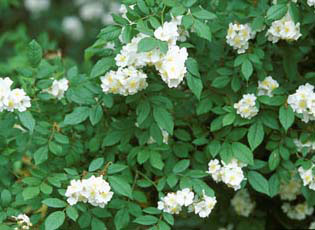
INVASIVE ALERT: THINK TWICE BEFORE YOU PLANT
Have you ever thought of purchasing trees, shrubs, or flowers, but you just aren’t quite sure what plants you want? Do you want these plants to produce fruit for wildlife watching in your yard or to create privacy from your neighbors? Regardless, when choosing plant species to place on your property, be aware of those not so friendly plants, such as autumn olive, Russian olive, multiflora roses and so on. Even though these species can be beautiful and fruitful they are still considered invasive and can have impacts on the habitat and surrounding area.
Flowers in April – James H. Miller
USDA, Forest Service
Invasive.org.
Plants like autumn olive were introduced into the US in the 1830s, and was commonly planted for wildlife food and cover until its invasive traits became apparent. It produces abundant fruits that are widely distributed by birds and mammals and like other non-native shrubs and trees, it leafs out early and retains its leaves late into the fall, which in turn shades out desirable native species and reduces the species diversity. It can be found in old fields, open woods, along forest edges, roadsides, stream banks, sand dunes, and other disturbed areas.
 These plant types tend to have root nodules that fix nitrogen, which results in increased nutrient levels in the soil, inviting weedy plants to grow and spread. This can also increase stream water nitrate concentration levels when they’re located near the stream banks. All of these have negative impacts on the surrounding habitats, and can have impacts on anglers, boaters, and water enthusiasts in general. Once the plant has been established it’s very hard to eradicate and sometimes impossible. So when it starts taking control of the banks we lose those opportunities for fishing, swimming, boating and so on.
These plant types tend to have root nodules that fix nitrogen, which results in increased nutrient levels in the soil, inviting weedy plants to grow and spread. This can also increase stream water nitrate concentration levels when they’re located near the stream banks. All of these have negative impacts on the surrounding habitats, and can have impacts on anglers, boaters, and water enthusiasts in general. Once the plant has been established it’s very hard to eradicate and sometimes impossible. So when it starts taking control of the banks we lose those opportunities for fishing, swimming, boating and so on.
Since plants like autumn olive and multiflora rose leaf out early its often easiest to locate for mapping and control efforts in the early spring, since the leaves of native vegetation are still absent. Control methods that work best for species like this include mechanical and chemical techniques. In its very earliest stages of invasion, when only young seedlings and plants are
present mechanical control such as hand pulling/digging, grazing of sheep and goats, and repeated cutting may be adequate enough to eradicate the invasive. However these methods are unpractical if the invasive is well established, in this scenario the addition of herbicide supplements may be necessary. Factors that have to be considered when using herbicides on a particular site include proximity to water or wetlands, presence or absence of native vegetation, potential for erosion and the effectiveness of the herbicide under consideration for use. Because autumn olive leafs out early and remains green much later than many native species, spring or fall treatment may minimize damage to desirable plants. Don’t forget however that most herbicide usage requires a permit from the Michigan Department of Environmental Quality.
So when choosing plant species for your yard be courteous to your neighbors, the surrounding habitat, and native plants and animals, because sometimes invasives are for a lifetime. Consider choosing native species that still attract animals and provide cover. For a list of those check here: http://www.michigan.gov/dnr/0,4570,7-153-10370_12146—,00.html
In the case that you do locate any invasive on or near your property, you can report it is using the Midwest Invasive Species Information Network (MISIN) which has an easy to use phone app or website for interactive online mapping.
This article is part of the ongoing series on invasive species funded in part with funds from the Michigan Invasive Species Grant Program through the Departments of Natural Resources, Environmental Quality, and Agriculture and Rural Development
